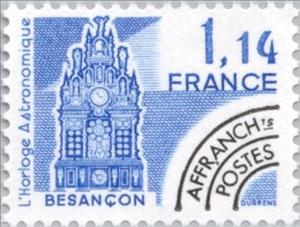Stamp: Besançon: Astronomical clock (France 1981)
Besançon: Astronomical clock (France 1981)
12 January (France ) within release Precancelled goes into circulation Stamp Besançon: Astronomical clock face value 1.14 French franc
| Stamp Besançon: Astronomical clock in catalogues | |
|---|---|
| Yvert et Tellier: | Yt:FR PR171 |
| Michel: | Mi:FR 2242 |
Stamp is horizontal format.
Also in the issue Precancelled:
- Stamp - Ajaccio: The Imperial Chapel face value 0.88;
- Stamp - Besançon: Astronomical clock face value 1.14;
- Stamp - Coucy-le-Château face value 1.84;
- Stamp - The Eysies de Tayac: cave of Font de Gaume face value 3.05;
Stamp Besançon: Astronomical clock it reflects the thematic directions:
A tower is a tall structure, taller than it is wide, often by a significant factor. Towers are distinguished from masts by their lack of guy-wires and are therefore, along with tall buildings, self-supporting structures.
A clock or chronometer is a device that measures and displays time. The clock is one of the oldest human inventions, meeting the need to measure intervals of time shorter than the natural units such as the day, the lunar month, and the year. Devices operating on several physical processes have been used over the millennia.
Astronomy is a natural science that studies celestial objects and the phenomena that occur in the cosmos. It uses mathematics, physics, and chemistry in order to explain their origin and their overall evolution. Objects of interest include planets, moons, stars, nebulae, galaxies, meteoroids, asteroids, and comets. Relevant phenomena include supernova explosions, gamma ray bursts, quasars, blazars, pulsars, and cosmic microwave background radiation. More generally, astronomy studies everything that originates beyond Earth's atmosphere. Cosmology is a branch of astronomy that studies the universe as a whole. .
A building or edifice is a structure with a roof and walls standing more or less permanently in one place, such as a house or factory. Buildings come in a variety of sizes, shapes and functions, and have been adapted throughout history for a wide number of factors, from building materials available, to weather conditions, to land prices, ground conditions, specific uses and aesthetic reasons. Buildings serve several needs of society – primarily as shelter from weather, security, living space, privacy, to store belongings, and to comfortably live and work. A building as a shelter represents a physical division of the human habitat (a place of comfort and safety) and the outside (a place that at times may be harsh and harmful).




